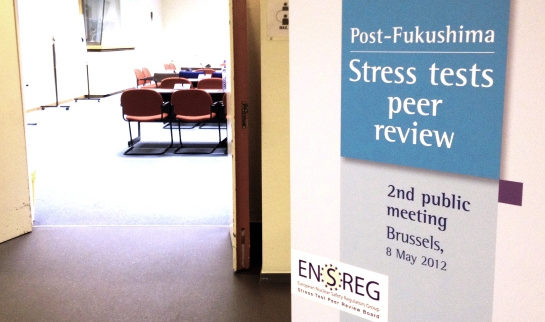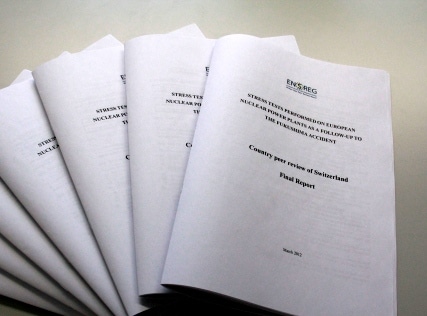Ten Years on from Fukushima (3/6): the EU Stress Test
Immediately following the serious reactor accident in Fukushima Daiichi, ENSI initiated a comprehensive root cause analysis and participated actively in the EU stress test. The tests at the time confirmed that, in international comparison, Swiss nuclear power plants have a high safety level. Despite these learnings, it is important to remain attentive at all times, to keep the proofs of safety up to date, to live a strong safety culture and to systematically analyse events. Because: “Safety is not a state, but a process”, emphasises Georg Schwarz, Deputy Director of ENSI.
Natural events were the trigger for the Fukushima Daiichi reactor accident: the severe earthquake, tsunami and subsequent flooding caused power outages and damage to the Fukushima Daiichi Nuclear Power Plant (NPP), which played a major role in the course of the major reactor accident. This prompted the international community and ENSI to reassess the safety of nuclear installations in the face of earthquakes and floods. In Europe, WENRA and ENSREG launched the EU stress test immediately following the accident.
The EU stress test was a direct consequence of the occurrences in Japan. The following questions were at the focus of the test:
- Would nuclear installations in Europe, especially nuclear power plants, withstand extreme earthquakes and floods?
- How can nuclear power plants cope with a loss of power and heat sink?
- What are the strategies deployed by nuclear power plants to cope with major accidents?
On 1 June 2011, ENSI decided that the Swiss nuclear power plants would also participate in the EU stress test. This meant that licensees had to submit well-founded review documents covering earthquakes and floods to ENSI by the end of October 2011. For its part, ENSI assessed the evidence and produced a Swiss Country Review Report for submission to ENSREG by the end of December of the same year.
Sequence of the EU stress test in three phases
Three-phase sequence of the EU stress test
Phase 1 – Self-assessment: licensees answered the three questions with regard to their installations. The safety regulators assessed the information provided by the licensees in a country review report and sent this to the EU and the other countries that participated in the EU stress test for peer review by the end of 2011.
Phase 2 – Peer review: in a two-week workshop in February 2012, the countries presented their reports and conclusions. They were questioned by experts from all EU countries as well as Switzerland and the Ukraine on the three main topics and their conclusions were assessed. A group of experts then visited each country. The statements contained in the country review reports were checked by means of these site visits. At the end of April 2012, the country review report had been created for each country.
Phase 3 – EU stress test follow-up, addressing the results and measures for the countries: the countries have undertaken to report periodically on the progress made in the processing of outstanding items from the peer review and on the implementation of specific improvement measures. At the end of 2012 and the end of 2014, each country submitted a National Action Plan, which was submitted to a further peer review in a workshop.
Switzerland has identified its open points
The EU stress test revealed eight open points, in respect of which ENSI issued additional requirements to the nuclear plants. This included an assessment of the extent to which the isolation of the reactor containment can withstand earthquakes and an analysis of waterway blockages, i.e. of possible blockages in rivers, for example at bridges or weirs.
ENSI also saw a need for additional clarification in respect of the resistance to earthquakes of the Wohlensee dam.
All of this evidence was provided by the Swiss nuclear power plants in the years following 2011. Some backfitting measures, which increased the safety margins, were also implemented.
ENSI continued its safety reviews even after the EU stress test was completed. As part of the ERSIM project, which was completed in 2015, the existing safety margins of Swiss nuclear power plants towards external events were systematically analysed. Based on the results of these analyses, areas were identified where backfitting measures can contribute to a further reduction in risk.
“A renewed review of earthquake and flood protection based on the latest findings is underway for earthquakes and nearing completion for floods”, says ENSI Deputy Director Georg Schwarz.
In general, the safety of Swiss NPPs is comprehensively reviewed at least every 10 years as part of the Periodic Safety Review (PSR).
Challenges at European level
The EU stress test was the first such review at European level in the nuclear sector. The public was able to participate in the EU stress test and comment on the reports submitted. Moreover, the whole review process was very transparent. In respect of public participation, the EU stress test was therefore something of a novelty.
The reviews in 2011 and 2012 showed that the peer review model can be successful: peer monitoring boosts a sense of responsibility on the part of participating countries in resolving the identified open points.
On the one hand, the challenge of inspecting foreign plants lies in the significant effort required by technical experts in drawing up comparable and meaningful findings from the plant surveys and reports. On the other hand, it is a challenge internationally to maintain attention for the follow-up phase.
After the second follow-up round, the participants’ interest in continuing to monitor the improvement measures identified in the EU stress test declined, although the points had still not yet been fully implemented in some countries.
In any case, seen from today’s perspective, the EU stress test model was able to establish itself. The EU Safety Directive, updated in 2014, requires a periodic topical peer review for a specific nuclear safety topic. Switzerland is also participating in the topical peer reviews.
This is the third part of an ENSI series marking the tenth anniversary of the Fukushima disaster of 11 March 2011. Quite independently of the EU stress test, ENSI also came to its own conclusions about the major reactor accident in Japan. A series of action plans were created in which ENSI publicly reported on the topics analysed and the corresponding progress in the considerations. Read more about this in the next part of the series, which will be released on 25 February 2021.








